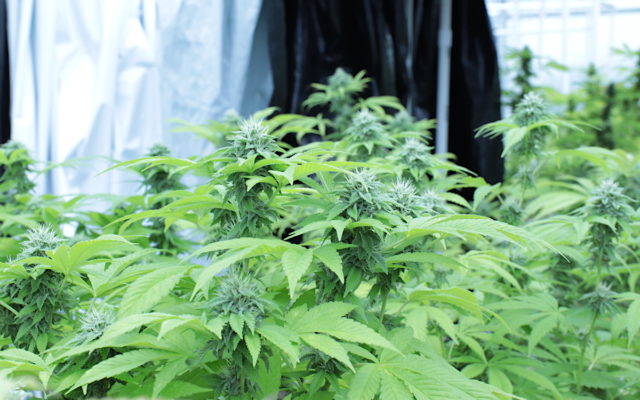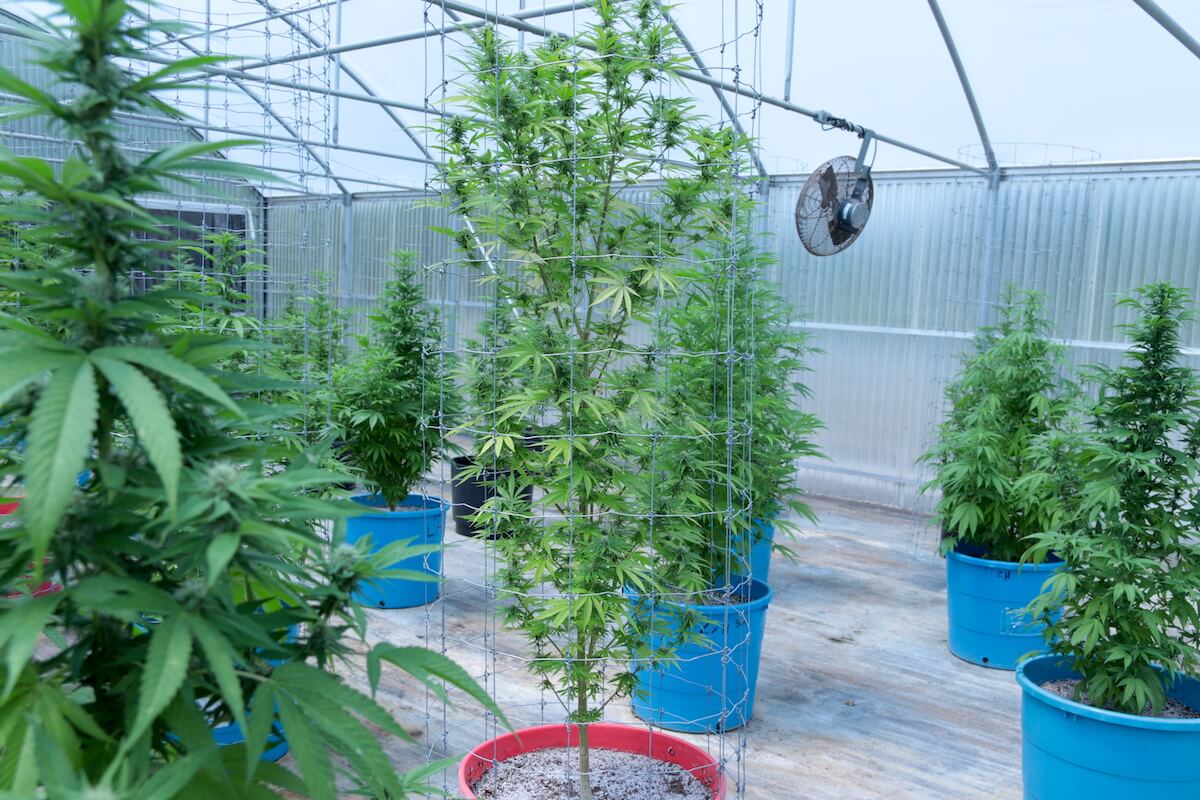
The legal marijuana industry has been booming in Oklahoma since voters passed State Question 788, in 2018, authorizing the drug for medical use. Since then, the Oklahoma Medical Marijuana Authority has issued 370,000 patient licenses and thousands of business licenses. Millions of dollars have flowed into state coffers along the way, and private investment has been staggering.
Though it might seem that medical marijuana with a low barrier to program access would put illegal drug traders out of business, Oklahoma’s black market marijuana industry continues to thrive, causing headaches for law enforcement, undercutting some legitimate business owners on price, and raising concerns about labor trafficking.
The situation has also roiled some who work in agriculture and those who represent them. Despite his initial opposition to SQ 788, Rep. Scott Fetgatter (R-Okmulgee) has been involved in writing much of the subsequent legislation affecting the industry.
He and other legislators say the dramatic expansion of marijuana grow operations is inflating land prices and has become an enormous concern for rural Oklahomans. In particular, communities want to know whether the marijuana operations nearby are following the laws of Oklahoma’s medical program.
“It’s the number one issue that we face in rural counties,” Fetgatter said in May. “Every senator or representative I know that lives in a rural district is facing this issue of trying to figure out how to fix it. The House has taken this issue very seriously.”
In the waning hours of the 2021 Oklahoma legislative session May 27, the Senate reconsidered its vote on SB 1033 — authored by Fetgatter and Sen. James Leewright (R-Bristow) — and narrowly sent the medical marijuana reform package to Gov. Kevin Stitt, who signed it.
The 49-page bill had failed in the Senate one day prior owing to concern about authorizing out-of-state visitor patient licenses and a new section allowing publicly traded companies to purchase up to 40 percent of the equity in an existing Oklahoma company that holds a medical marijuana growing, processing or transportation license.
Several senators ultimately switched their votes to be in favor of SB 1033 after language was added authorizing the State Department of Health — which houses the OMMA — to sign memoranda of understandings with other state agencies for the enforcement of laws regulating medical marijuana in Oklahoma.
“People are bringing in inferior marijuana products into grow houses to launder that product,” said Sen. Shane Jett (R-Shawnee) during debate in favor of SB 1033. “They are pretending to grow it here. Capital goes where it is welcome and stays where it is rewarded. The hazard here is that, if we do nothing, you have those who would like to have one of the most permissible marijuana industries in the United States because this body and the legislative body across the Capitol did nothing.”
Jett said there are “more than 100” marijuana grow operations within a 15-minute drive of his home. Sen. Casey Murdock (R-Felt) said his sprawling northwest Oklahoma district has seen a similar spike.
“The stories I have heard from my constituents, they are scary. [Grow operations] are guarding their places with AK-47s. They have dogs. There are high fences. There are 20, 30 or 40 people working at these places,” Murdock said before referencing a conversation he had with the superintendent of Seiling Public Schools. “There are so many people working at these grows that are well-armed, he said, ‘We only have five deputy sheriffs.’ He’s concerned for his community.”
Some operations have international backing
Authorities say many of the new medical marijuana operations they believe may be breaking the law have out-of-state and even international connections.
While international drug-trafficking groups from south of the U.S. border have had a significant presence here for decades, law enforcement is now seeing a rise in groups with ties to China and elsewhere, said Mark Woodward, public information officer for the Oklahoma Bureau of Narcotics and Dangerous Drugs.
“It’s become more and more common in the last nine or 10 months,” he said. “That’s when we started to see an influx of farms coming to Oklahoma run by Chinese workers who come from California and New Mexico buying up land and starting large commercial grows. In some cases, there’s no wrongdoing. But in some cases, these are tied to various criminal gang organizations that are nothing more than black market growers who have come here because the land is cheap and the laws are less restrictive than in other places.”
Meanwhile, the enormous increase in grow operations — whether foreign or domestic, legal or illegal — is causing what some say is an unsustainable demand for land, water and infrastructure resources, making some farmers and ranchers increasingly uncomfortable about how the medical marijuana industry is changing rural Oklahoma.
Logan County raid highlights problem

Sometimes, the illegal marijuana trade takes advantage of the legal one.
“We have criminal groups who hide behind our medical program in Oklahoma,” Woodward said. “The real day-to-day movement of money is over to China, and the rest of Asia, and Europe. You can have a local, innocent looking farm, growing product that ends up all over the world.”
Woodward said one tactic is to operate a legal grow operation that then sells its goods to the black market.
“They will get a permit, which doesn’t cost much money, and they will set up a grow operation and then sell what they grow to the black market, out of state, or here in Oklahoma,” Woodward said. “They try to make it look as above-board as they can on the surface with the licensing, but it’s never intended for medical use.”
On April 23, agents from OBNDD and sheriff deputies raided one such operation at a house registered as the site of a licensed medical marijuana grower in Logan County.
In the home, on the outskirts of Guthrie, agents found 100 pounds of marijuana in vacuum-sealed plastic bags, piles of sod containing stems, indicating that a previous harvest had already taken place on site, and more than 11,000 other plants that would be ready to harvest soon.
According to the arrest warrant affidavit, a bookshelf concealed an entry into a hidden room inside the house. Inside, agents found a shoebox wrapped in rubber bands which contained passports and checks. A wire transfer receipt for $170,000 sent to Dong Q. Yang was also found.
Yang had landed on OBNDD’s radar a month before when he was stopped by Oklahoma City police after leaving alleged marijuana stash houses that was under surveillance in Edmond and OKC. During a search of Yang’s vehicle, officers found $60,000, mostly in small-denomination bills, which had been vacuum sealed in plastic.
Through a translator, Yang initially told the officers he had moved to Oklahoma a short time before and had been given the money to invest in a marijuana business. He later told officers he had planned to buy a house with the money. Yang’s companion, Ronghua Chen, handed officers a purse with $5,000 inside.
Chen, Yang and two others were arrested when the search warrant was served on the Logan County property, according to court records. Officers also interviewed six more workers at the site, all of whom were Chinese.
Illegal, foreign operations not uncommon
Law enforcement officials say organized crime has become an increasingly significant presence in marijuana trafficking in a number of states, including California, Colorado and Washington, all of which have legalized marijuana to some extent. That makes the trend in Oklahoma part of a wider national phenomenon.
“The phone calls really started coming in September or October,” Woodward said. “These people in these counties were used to seeing marijuana farms popping up, but when these farms with Chinese workers started hitting all 77 counties almost overnight, people start getting suspicious.”
In May, OBNDD agents raided an operation in Erick, Oklahoma — a tiny town in Beckham County, near the state’s western border — yielding thousands of plants. Like in Logan County, the people running the operation were Asian and new to Oklahoma.
State law has required grow operations to be at least 75 percent owned by someone who has been an Oklahoma resident for two years or more, but this is not a fail-safe measure against large criminal organizations.
The official owner of the Guthrie property — Andrea Sheung — has lived in Oklahoma since at least 2009, according to court records. But Woodward said organizations like the one in Logan County are often complex.
“There’s always a lot to unpack,” Woodward said. “Part of the issue is that these groups prop someone up as a straw owner to meet the residency requirements, and they move money to that person. They claim ownership when, in actuality, they are a straw or ghost owner, and their only knowledge of what’s going on is they go and get a check every month as compensation for claiming to be the owner.”
Woodward said in many cases those working at grow operations are far from the actual money and power.
“The people running the operation and calling the shots are usually no where near the operation,” he said. “They’re out of state, and possibly even international.”
Concerns about human trafficking
Besides feeding the illegal drug market, operations of this type in other states have sometimes been found to depend on worker exploitation and even human trafficking.
Fetgatter said this is one of many concerns he has about the current state of Oklahoma’s medical marijuana industry.
“I think there’s been some evidence of human trafficking in some of these cases around the country,” he said. “There’s definitely harsh working conditions. We’ve seen that in Oklahoma with the raids that have been done.”
Woodward said OBNDD does not believe the workers in the grow operations it has raided so far are trafficking victims.
“We have interviewed them through translators, and most of them will tell you they’re not a victim,” he said. “They don’t see themselves that way. They won’t complain. Whether it’s out of fear or not, we don’t know, but it doesn’t seem like we’ve run into that yet. That’s not to say it isn’t happening, though.”
OMMA hires more inspectors as black market thrives
When State Question 788 was on the ballot, Fetgatter opposed it. But even in its passage, he saw a silver lining: A chance to eradicate, or at least cripple, the state’s marijuana black market. Three years later, he says that effort has failed thus far.
“The black market is alive and well in the state of Oklahoma, and it’s massive,” he said. “And it’s so open. These black market groups talk about it in magazine articles. They’re very open and forthright about what they’re doing. Because we could not get our act together in state government, from the Legislature to the bureaucrats all the way to the governor, we had been failing the citizens of Oklahoma when it comes to black market marijuana.”
Woodward said these groups are drawn to Oklahoma by the state’s cheap land prices and the medical marijuana program’s low barrier to entry for growers. A grow license costs just $2,500.
OMMA spokeswoman Terri Watkins said her agency does keep an eye out for applications that might be suspect.
“We contact the Oklahoma Bureau of Narcotics with information we receive on questionable activity, but the applications are verified here,” she said.
The OMMA has recently hired 10 more field inspectors, and the passage of HB 2904 will also help. The bill directs the Department of Health to hire 76 additional staff members within the OMMA: 62 compliance and enforcement positions, six legal and financial positions, four investigatory officers and four positions for planning and logistical duties.
Rural resource crunch leads to task force

For people living in the rural areas where marijuana grow operations, legal or otherwise, are proliferating, illegal drug trafficking is not always the primary concern.
Five groups — the American Farmers & Ranchers, Oklahoma Agribusiness Retailers Association, Oklahoma Cattlemen’s Association, Oklahoma Agricultural Cooperative Council and Oklahoma Farm Bureau — recently formed a task force to examine the impact of the state’s medial marijuana industry on rural agriculture.
Among the topics of concern: stress on rural water and electricity infrastructure, interruptions to fertilizer and pesticide applications and inflated land prices because marijuana growers paying higher than listed prices for real estate.
Oklahoma Farm Bureau’s senior director of public policy, Steve Thompson, said he’s heard stories about all of the above.
“A number of these operations have opened up along property lines, and if a farmer or rancher uses an herbicide, even applied properly, that the chemicals can then end up on plants, and even inside a grow operation, because it gets pulled into the ventilation and damages crops,” he said. “So because the liability is so great, we’ve had some members who just won’t spray like they normally do. It’s created a situation where they are constantly trying to find work-arounds.”
The grow operations also tax local infrastructure not meant to deal with such high levels of water and energy usage.
“There’s really only so much supply and capacity,” Thompson said. “These facilities have gone up around the state in huge numbers, and they’re on residential systems pulling industrial amounts of water and electric. The industrial loads on the grid can cause loss of service, and, in some cases, those city and county governments don’t really want to invest in upgrading because they don’t know if the bubble will burst at some point.”
Thompson said the goal of the task force was to improve the ability of rural agriculture producers to exist alongside the state’s medical marijuana industry.
“As far as its goals, that would be to come up with a unified set of recommendations to the state Legislature and to our congressional delegation that can help agriculture producers evolve with the industry,” Thompson said. “We had hoped that would happen this session but that doesn’t appear to be the case.”
Legislators hope SB 1033, HB 2904 help

Fetgatter said ideally the OMMA would have 100 inspectors in the field to help legitimate businesses get up and running and to root out bad actors.
Rep. Ronny Johns (R-Ada) praised Fetgatter’s efforts while echoing his concerns for rural districts. Still, he said he would like the OMMA to be under the umbrella of the Alcoholic Beverage Laws Enforcement Commission, which is charged with enforcing Oklahoma’s alcohol laws.
“It is a huge issue in rural Oklahoma,” he said. “I’m disappointed that we [did not get] the bill that would move OMMA to ABLE to the governor. I think it would provide more accountability. I know the grows in my district want things done right and welcome thorough audits. We have got to make sure the foreign investors are going by the book. OMMA has got to get more agents in the field, which they have committed to do.”
(Editor’s note: Tres Savage contributed to this report, which was updated at 2:42 p.m., Saturday, June 12, to remove a duplicative quote.)





















